Are Sport Clubs Mediating Urban Expressive Crimes?—London as the Case Study
Abstract
1. Introduction
2. Background
3. Materials and Methods
3.1. Data Source
3.2. Methods
3.2.1. Bivariate Moran’s I Map
- : the value of variable X (number of sports clubs) at location i;
- : the value of variable Y (sexual offence rate) at neighboring location j;
- : spatial weights matrix (defined by contiguity or distance from location i to location j);
- : variance of variable X.
3.2.2. Seasonal Trend Decomposition Using Loess
3.2.3. Difference-in-Differences Approach
3.2.4. Geographically and Temporally Weighted Regression (GTWR)
4. Results
4.1. Sport Clubs & Expressive Crimes in London
4.2. Case Study: Stadium Events & Disproportionate Crime Changes
4.3. Driving Mechanism
5. Discussion
6. Conclusions
Author Contributions
Funding
Institutional Review Board Statement
Informed Consent Statement
Data Availability Statement
Acknowledgments
Conflicts of Interest
Abbreviations
| STL | Seasonal Trend decomposition using Losse |
| GTWR | Geographically Temporal Weighted Regression |
| DID | Difference-in-difference |
References
- Jugl, I.; Bender, D.; Lösel, F. Do Sports Programs Prevent Crime and Reduce Reoffending? A Systematic Review and Meta-Analysis on the Effectiveness of Sports Programs. J. Quant. Criminol. 2023, 39, 333–384. [Google Scholar] [CrossRef]
- Spruit, A.; van der Put, C.; van Vugt, E.; Stams, G.J. Predictors of intervention success in a sports based program for adolescents at risk of juvenile Delinquency. Int. J. Offender Ther. Comp. Criminol. 2018, 62, 1535–1555. [Google Scholar] [CrossRef]
- College of Policing. Sports Programmes Designed to Prevent Crime and Reduce Reoffending. 2023. Available online: https://www.college.police.uk/research/crime-reduction-toolkit/sports-programmes-designed-prevent-crime-and-reduce-reoffending (accessed on 15 October 2025).
- Lösel, F.; Farrington, D.P. Direct protective and buffering protective factors in the development of youth violence. Am. J. Prev. Med. 2012, 43, 8–23. [Google Scholar] [CrossRef] [PubMed]
- Cohen, L.E.; Felson, M. Social Change and Crime Rate Trends: A Routine Activity Approach. Am. Sociol. Rev. 1979, 44, 588–608. [Google Scholar] [CrossRef]
- Shields, D.L.; Funk, C.D.; Bredemeier, B.L. Relationships among moral and contesting variables and prosocial and antisocial behavior in sport. J. Moral Educ. 2018, 47, 17–33. [Google Scholar] [CrossRef]
- Haudenhuyse, R.; Hayton, J.; Parnell, D.; Verkooijen, K.; Delheye, P. Boundary Spanning in Sport for Development: Opening Transdisciplinary and Intersectoral Perspectives. Soc. Incl. 2020, 8, 123–128. [Google Scholar] [CrossRef]
- Durkheim, D. The Division of Labor in Society; Simpson, F., Translator; The MacMillan Company: New York, NY, USA, 1933. [Google Scholar]
- Bandura, A. Self-efficacy: Toward a unifying theory of behavioral change. Psychol. Rev. 1977, 84, 191–215. [Google Scholar] [CrossRef]
- Andres, L.; Fabel, M.; Rainer, H. How much violence does football hooliganism cause? J. Public Econ. 2023, 225, 104970. [Google Scholar] [CrossRef]
- NPCC. Over 300 Domestic Abuse Offences Linked to Euros. 2024. Available online: https://news.npcc.police.uk/releases/police-record-over-three-hundred-domestic-abuse-offences-linked-to-euros-tournament (accessed on 15 October 2025).
- Kurland, J.; Johnson, S.D.; Tilley, N. Offenses around Stadiums: A Natural Experiment on Crime Attraction and Generation. J. Res. Crime Delinq. 2013, 51, 5–28. [Google Scholar] [CrossRef]
- Williams, R.K. Sports and Crime. EBSCO Knowledge Advantage. 2024. Available online: https://www.ebsco.com/research-starters/sports-and-leisure/sports-and-crime#full-article (accessed on 15 October 2025).
- Crozier, A.J.; Carmichael, M.A.; Townsend, J.R.; Bingham, J.M.; Stenner, B.J. Norms in sport: A scoping review. Int. Rev. Sport Exerc. Psychol. 2024, 17, 645–667. [Google Scholar] [CrossRef]
- Uszaki, D.W. Beyond the Scoreboard: Using Athletics to Build Life Skills; National Federation of State High School Associations: Indianapolis, IN, USA, 2025. [Google Scholar]
- Hirschi, T. Causes of Delinquency; University of California Press: Berkeley, CA, USA, 1969. [Google Scholar]
- Mayor of London. Mayor Announces New £1 m Sports Investment Featuring Holiday Activities for Young People at Greatest Risk of Violence; Mayor of London: London, UK, 2025. [Google Scholar]
- Allen, G.; Wong, H. Knife Crime Statistics: England and Wales. UK Parliament Research Briefing. 2025. Available online: https://commonslibrary.parliament.uk/research-briefings/sn04304/ (accessed on 15 October 2025).
- Office for National Statistics. Crime in England and Wales: Year Ending June 2023; Office for National Statistics: Newport, UK, 2023.
- Bruner, M.W.; McLaren, C.D.; Sutcliffe, J.T.; Gardner, L.A.; Lubans, D.R.; Smith, J.J.; Vella, S.A. The effect of sport-based interventions on positive youth development: A systematic review and meta-analysis. Int. Rev. Sport Exerc. Psychol. 2021, 16, 368–395. [Google Scholar] [CrossRef]
- Morgan, H.; Parker, A.; Marturano, N. Evoking hope in marginalised youth populations through non-formal education: Critical pedagogy in sports-based interventions. Br. J. Sociol. Educ. 2021, 42, 307–332. [Google Scholar] [CrossRef]
- Rees, D.I.; Schnepel, K.T. College Football Games and Crime. J. Sport. Econ. 2009, 10, 68–87. [Google Scholar] [CrossRef]
- Card, D.; Dahl, G.B. Family Violence and Football: The Effect of Unexpected Emotional Cues on Violent Behavior. Q. J. Econ. 2011, 126, 103–143. [Google Scholar] [CrossRef] [PubMed]
- Kurland, J.; Tilley, N.; Johnson, S. Football pollution: An investigation of spatial and temporal patterns of crime in and around stadia in England. Secur. J. 2017, 31, 665–684. [Google Scholar] [CrossRef]
- Marie, O. Police and thieves in the stadium: Measuring the (multiple) effects of football matches on crime. J. R. Stat. Soc. Ser. A (Stat. Soc.) 2016, 179, 273–292. [Google Scholar] [CrossRef]
- Brantingham, P.L.; Brantingham, P.J. Nodes, paths and edges: Considerations on the complexity of crime and the physical environment. J. Environ. Psychol. 1993, 13, 3–28. [Google Scholar] [CrossRef]
- Leroch, M.A. Punishment as Defiance: Deterrence and Perverse Effects in the Case of Expressive Crime. CESifo Econ. Stud. 2014, 60, 581–598. [Google Scholar] [CrossRef]
- Summers, L.; Johnson, S.D. Does the Configuration of the Street Network Influence Where Outdoor Serious Violence Takes Place? Using Space Syntax to Test Crime Pattern Theory. J. Quant. Criminol. 2017, 33, 397–420. [Google Scholar] [CrossRef]
- Jiang, C.; Liu, L.; Qin, X.; Zhou, S.; Liu, K. Discovering Spatial-Temporal Indication of Crime Association (STICA). ISPRS Int. J. Geo-Inf. 2021, 10, 67. [Google Scholar] [CrossRef]
- Wang, R.; Li, Y. Bayesian Structural Time Series and Geographically Weighted Logistic Regression Modelling Impacts of COVID-19 Lockdowns on the Spatiotemporal Patterns of London’s Crimes. ISPRS Int. J. Geo-Inf. 2024, 13, 18. [Google Scholar] [CrossRef]
- Cohn, E.G.; Rotton, J. Even criminals take a holiday: Instrumental and expressive crimes on major and minor holidays. J. Crim. Justice 2003, 31, 351–360. [Google Scholar] [CrossRef]
- College of Policing. Hot Spots Policing. 2022. Available online: https://www.college.police.uk/guidance/hot-spots-policing (accessed on 15 October 2025).
- Block, C.R.; Block, R. Street Gang Crime in Chicago; U.S. Department of Justice: Washington, DC, USA, 1993. [Google Scholar]
- Felson, M. Crime and Nature; SAGE Publications: Thousand Oaks, CA, USA, 2006. [Google Scholar]
- Leroch, M.A. Crime: Expressive Crime and the Law. In Encyclopedia of Law and Economics; Springer: Berlin/Heidelberg, Germany, 2019. [Google Scholar] [CrossRef]
- Sampsell-Jones, T. Culture and Contempt: The Limitations of Expressive Criminal Law. Seattle Univ. Law Rev. 2005, 27, 133. [Google Scholar]
- Bean, P.; Billingsley, R. Drugs, Crime and Informers. In Informers; Willan: New York, NY, USA, 2001; pp. 37–49. [Google Scholar]
- Shepard, D. A two-dimensional interpolation function for irregularly-spaced data. In Proceedings of the 23rd ACM National Conference, New York, NY, USA, 27–29 August 1968; pp. 517–524. [Google Scholar]
- Moran, P.A.P. Notes on continuous stochastic phenomena. Biometrika 1950, 37, 17–23. [Google Scholar] [CrossRef]
- Lee, S.I. Developing a bivariate spatial association measure: An integration of Pearson’s r and Moran’s I. J. Geogr. Syst. 2001, 3, 369–385. [Google Scholar] [CrossRef]
- Anselin, L. Spatial externalities, spatial multipliers, and spatial econometrics. Int. Reg. Sci. Rev. 2003, 26, 153–166. [Google Scholar] [CrossRef]
- Anselin, L. Local Indicators of Spatial Association—LISA. Geogr. Anal. 1995, 27, 93–115. [Google Scholar] [CrossRef]
- Cleveland, R.B.; Cleveland, W.S.; McRae, J.E.; Terpenning, I. STL: A seasonal-trend decomposition procedure based on loess. J. Off. Stat. 1990, 6, 3–73. [Google Scholar]
- Krake, P.; Kugler, P.; Sachs, S.; Schmitt, S. Uncertainty-aware robust trend extraction for time series decomposition. Inf. Sci. 2024, 660, 119685. [Google Scholar] [CrossRef]
- Itskovich, Y. Economic Inequality, Relative Deprivation, and Crime: An Individual-Level Examination. Justice Q. 2024, 42, 637–658. [Google Scholar] [CrossRef]
- Ciacci, A.; Tagliafico, G. Measuring the Existence of a Link between Crime and Social Deprivation within a Metropolitan Area. Rev. Estud. Andal. 2020, 40, 192–194. [Google Scholar] [CrossRef]
- Reilly, J.; Naumann, D.; Morris, L.; Blackburn, L.; Brooks, A. Injury by knife crime amongst children is associated with socioeconomic deprivation: An observational study. Pediatr. Surg. Int. 2022, 39, 8. [Google Scholar] [CrossRef] [PubMed]
- McCall, P.L.; Land, K.C.; Dollar, C.B.; Parker, K.F. The Age Structure–Crime Rate Relationship: Solving a Long-Standing Puzzle. J. Quant. Criminol. 2013, 29, 167–190. [Google Scholar] [CrossRef]
- Marvell, T.B.; Moody, C.E. Age Structure and Crime Rates: The Conflicting Evidence. J. Quant. Criminol. 1991, 7, 237–273. [Google Scholar] [CrossRef]
- Tottenham Hotspur Football Club. Getting Here–Travel Advice; Tottenham Hotspur Football Club: London, UK, 2025; Available online: https://www.tottenhamhotspur.com/the-stadium/attending-matches/getting-here/ (accessed on 15 October 2025).
- Metropolitan Police. Hermitage and Gardens: Our Priorities; Metropolitan Police: London, UK, 2025. [Google Scholar]
- Menaker, B.; McGranahan, D. Game-day alters crime pattern in the vicinity of sport stadiums. J. Sport Manag. 2019, 4. Available online: https://www.researchgate.net/publication/361880450_Game_Day_Alters_Crime_Pattern_in_the_Vicinity_of_Sport_Venues_in_Cleveland_OH (accessed on 15 October 2025).
- Ristea, A.; Kurland, J.; Resch, B.; Leitner, M.; Langford, C. Estimating the spatial distribution of crime events in urban environments. Environ. Plan. B Urban Anal. City Sci. 2018, 45, 1109–1130. [Google Scholar] [CrossRef]
- Ge, Q.; Sarmiento-Barbieri, I.; McMillen, D. Sporting events, emotional cues, and crime: Spatial and temporal evidence from Chicago. J. Econ. Behav. Organ. 2018, 146, 236–257. [Google Scholar] [CrossRef]
- Planells Struse, S.; Montolio, D. The effect of football matches on crime patterns in Barcelona. Reg. Sci. Urban Econ. 2014, 44, 1–7. [Google Scholar] [CrossRef]
- Montolio, D.; Planells, S. Measuring the negative externalities of a private leisure activity: Hooliganism in football matches. J. Sport. Econ. 2015, 16, 496–522. [Google Scholar] [CrossRef]
- Zhang, D. On the subway safety and crime prevention in city. J. Urban Manag. 2013, 2, 33–46. [Google Scholar]
- Kadar, C.; Feuerriegel, S. Leveraging mobility flows from location technology for crime prediction. Comput. Environ. Urban Syst. 2020, 83, 101514. [Google Scholar] [CrossRef]
- Chen, X.; Ye, Z. Subway passenger flow prediction for special events using Bi-LSTM neural networks. Transp. Res. Part C Emerg. Technol. 2020, 111, 1–16. [Google Scholar] [CrossRef]
- Huang, J.; Zhang, M. Identifying subway passenger flow under large-scale events. J. Transp. Geogr. 2021, 92, 103034. [Google Scholar] [CrossRef]
- Deelen, I.; Jansen, W. Do objective neighbourhood characteristics relate to adolescents’ leisure activities and crime involvement? J. Youth Stud. 2017, 20, 997–1016. [Google Scholar] [CrossRef]
- Roncek, D.; Maier, P. Bars, blocks, and crimes revisited: Linking the theory of routine activities to the empiricism of “hot spots”. Criminology 1991, 29, 725–753. [Google Scholar] [CrossRef]
- Asselineau, M. Leisure places downstairs: A pleasure or a failure? Urban Stud. 1998, 35, 1589–1606. [Google Scholar] [CrossRef]
- Bae, J. “Hobby or work extension?” Exploring the characteristics of corporate sports clubs. Int. J. Hum. Resour. Manag. 2025, 36, 1123–1147. [Google Scholar] [CrossRef]
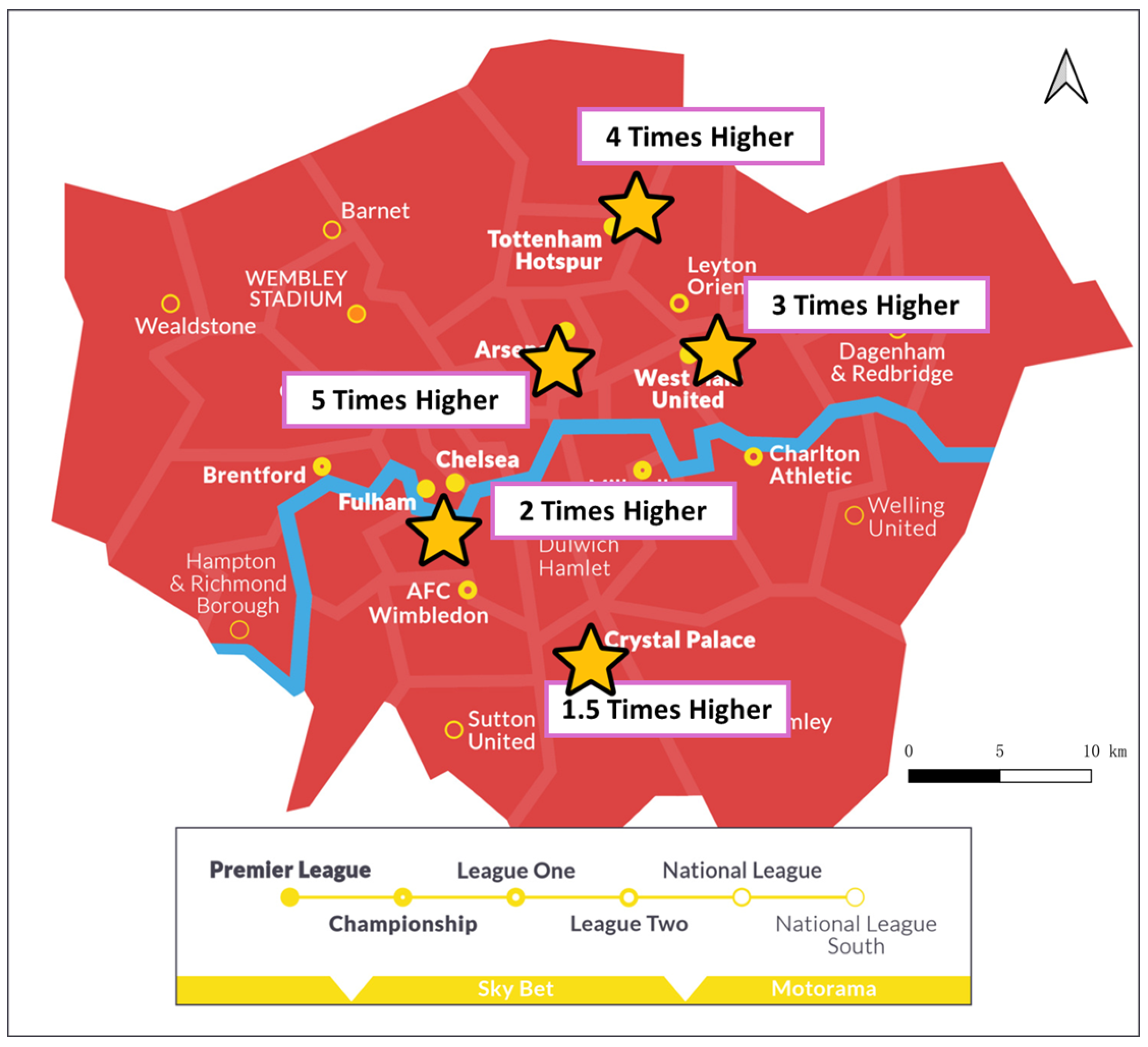
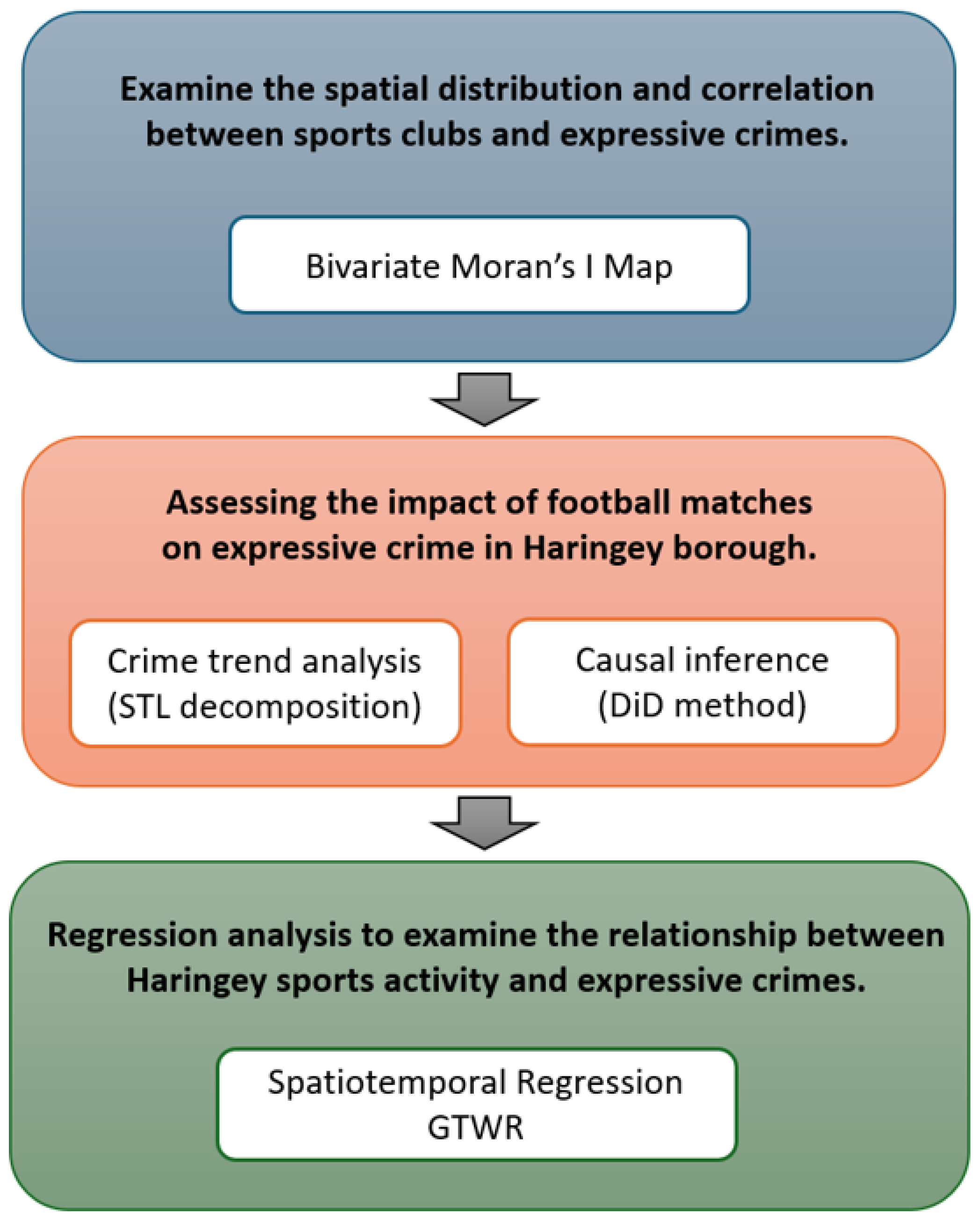
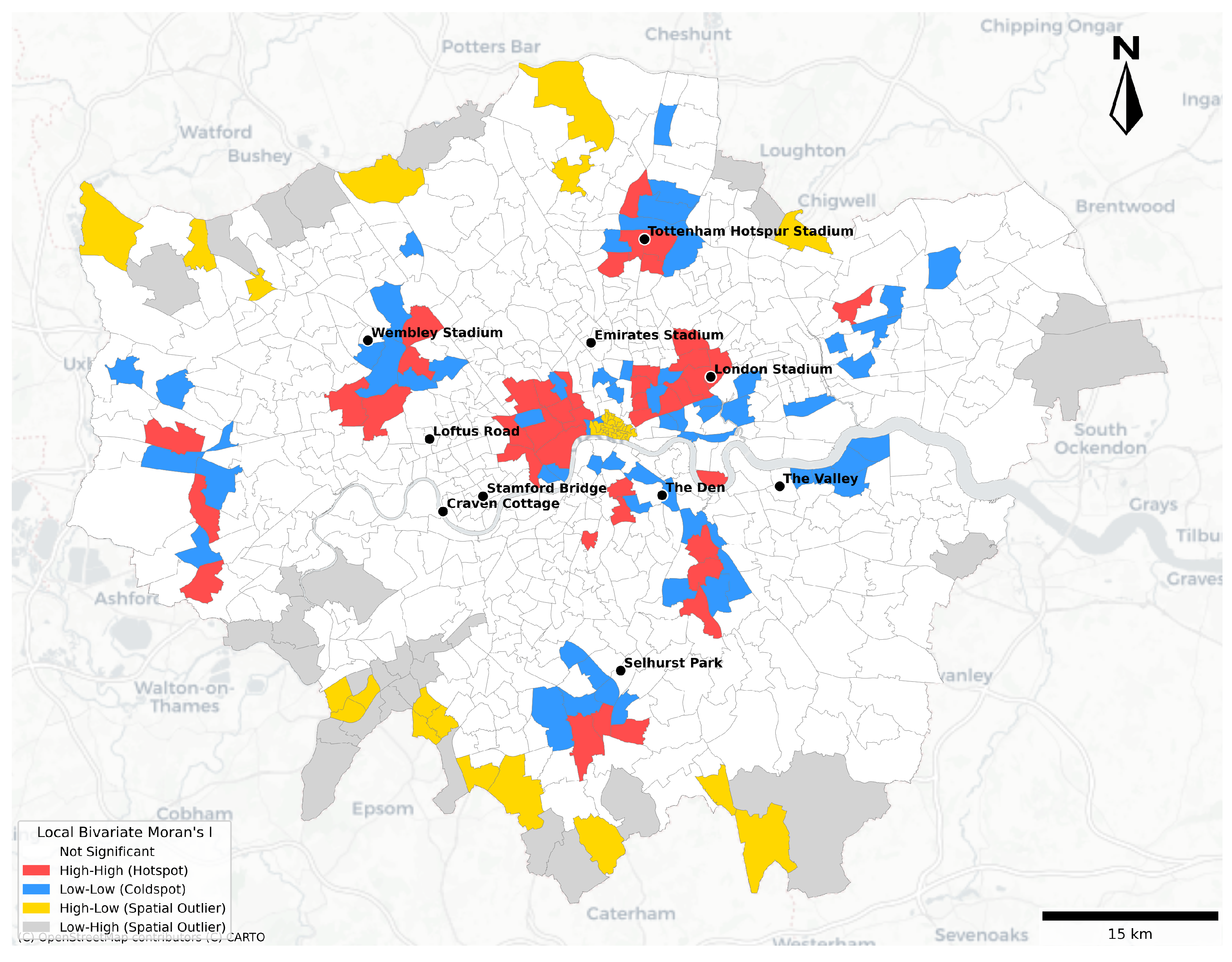
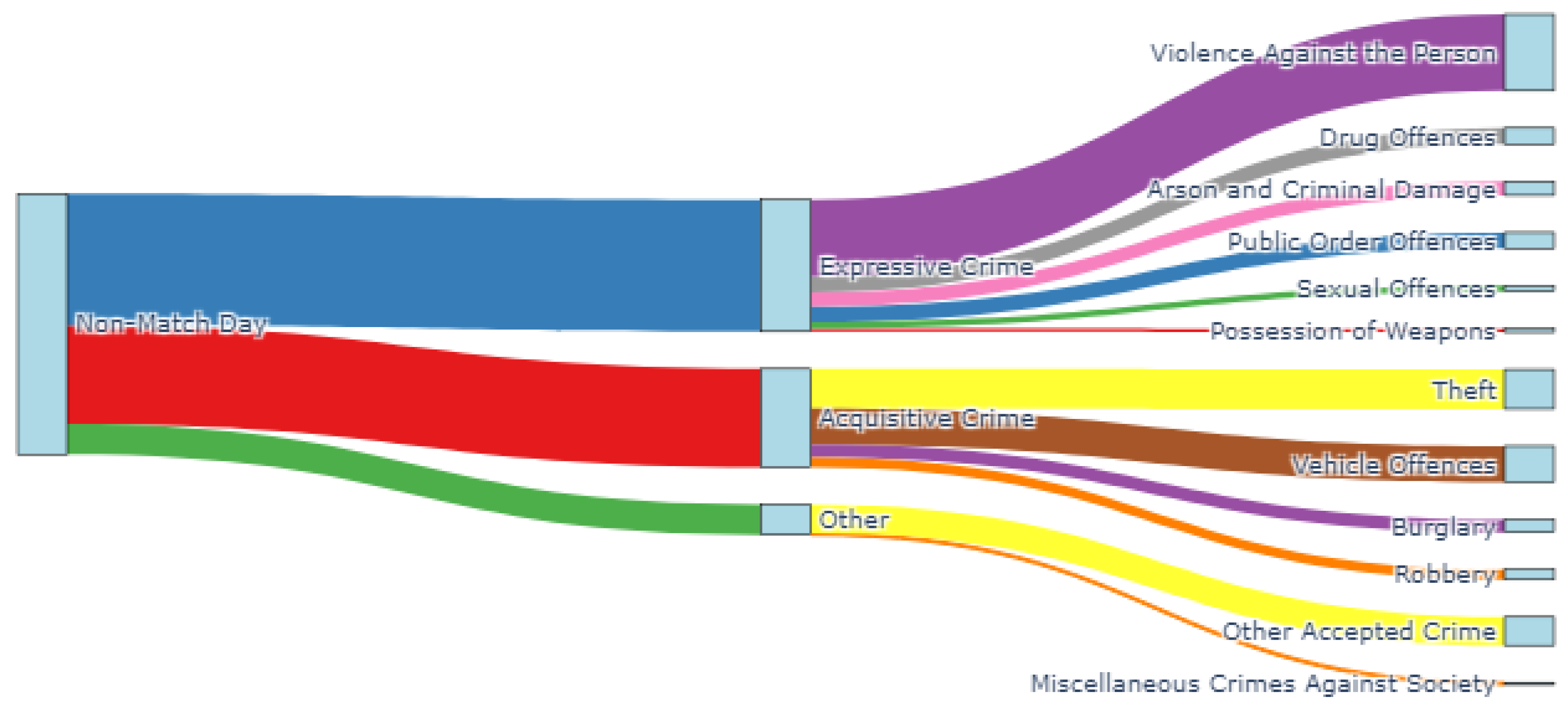
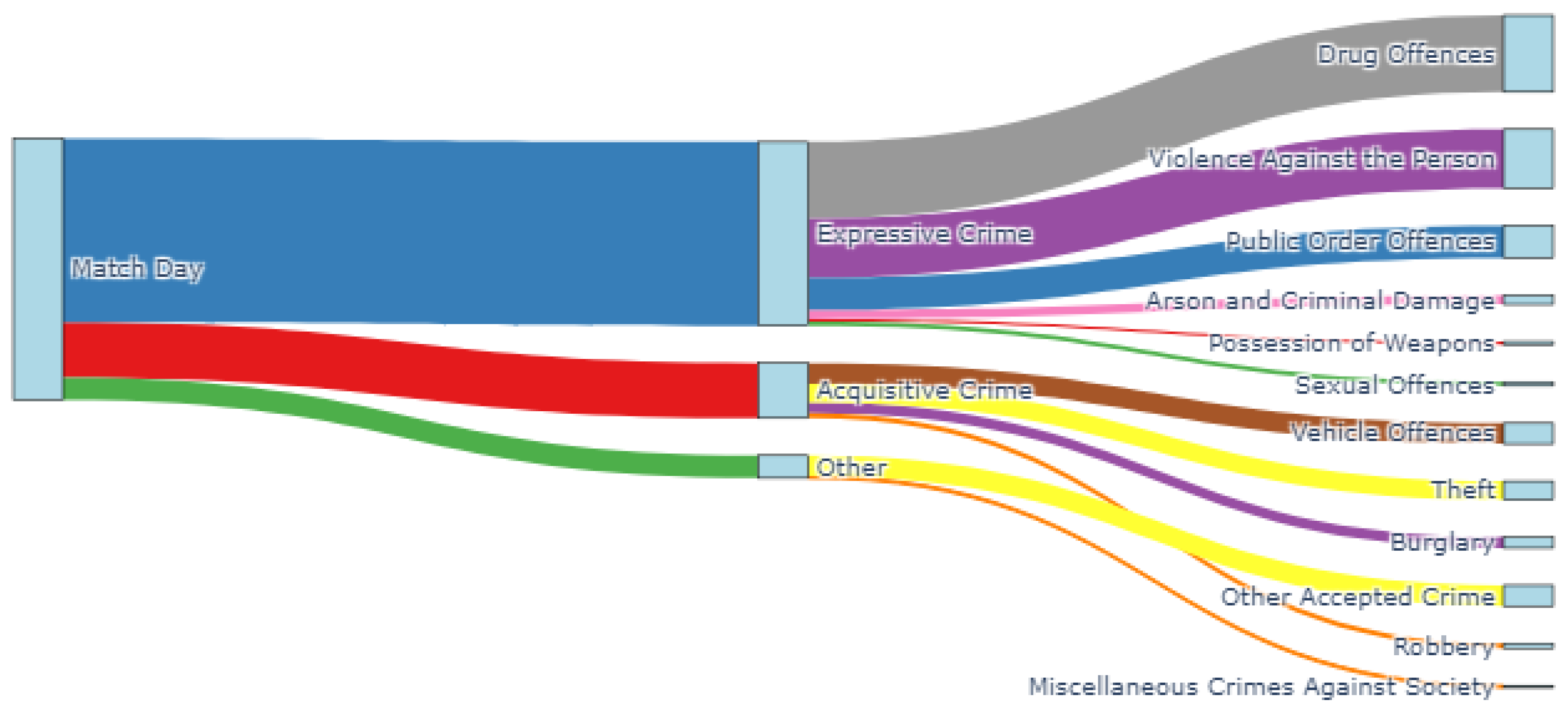
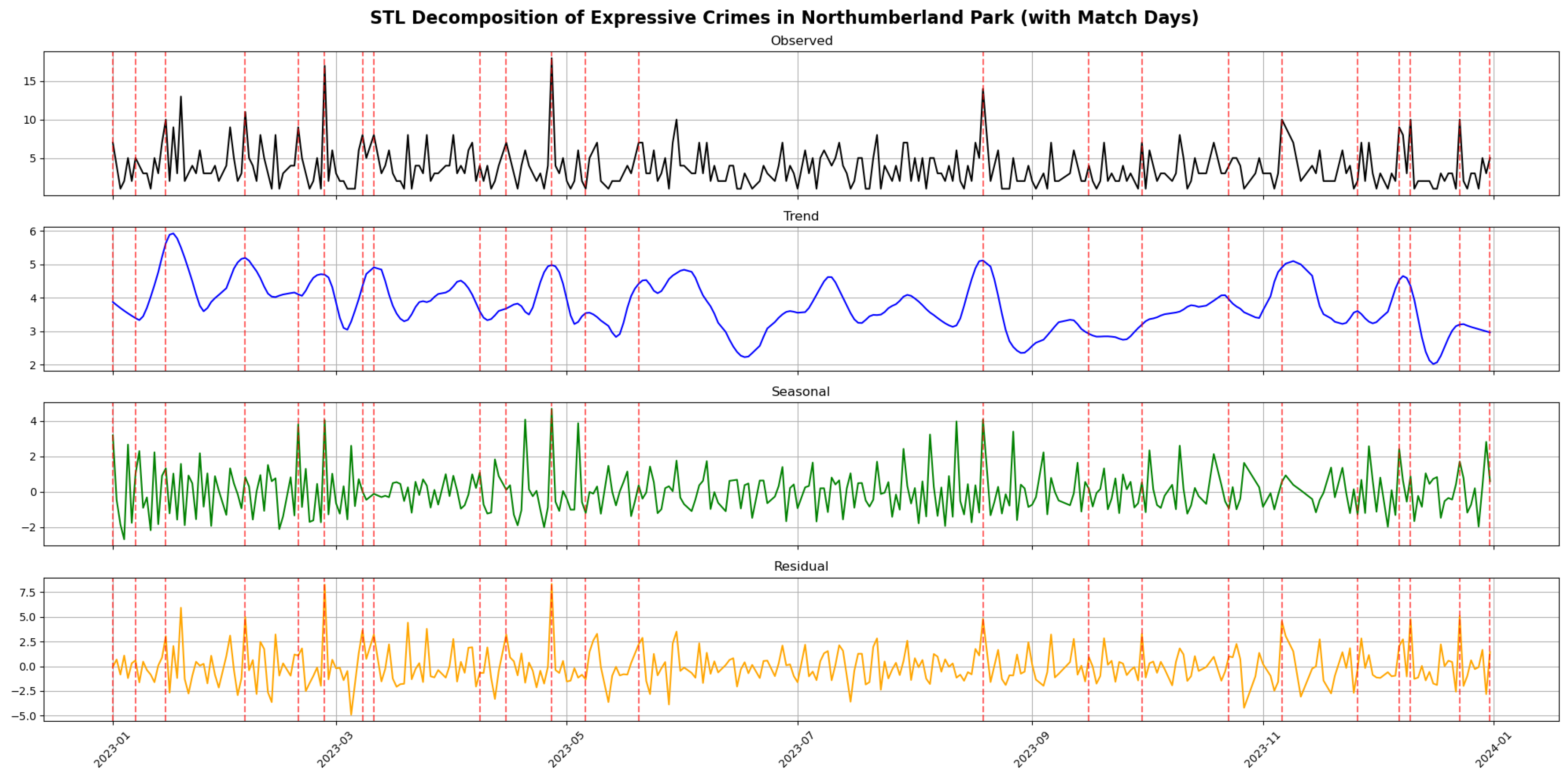
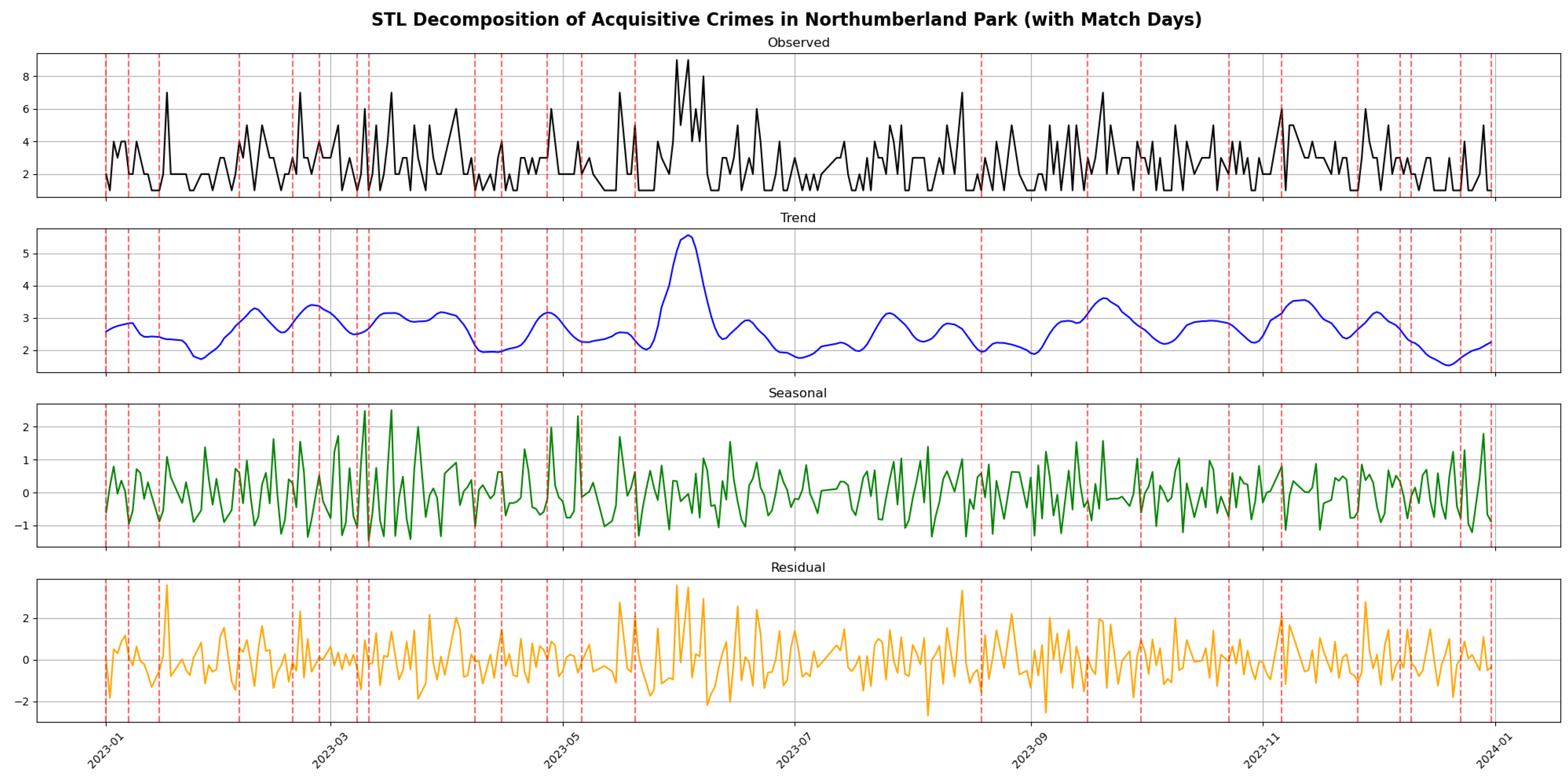
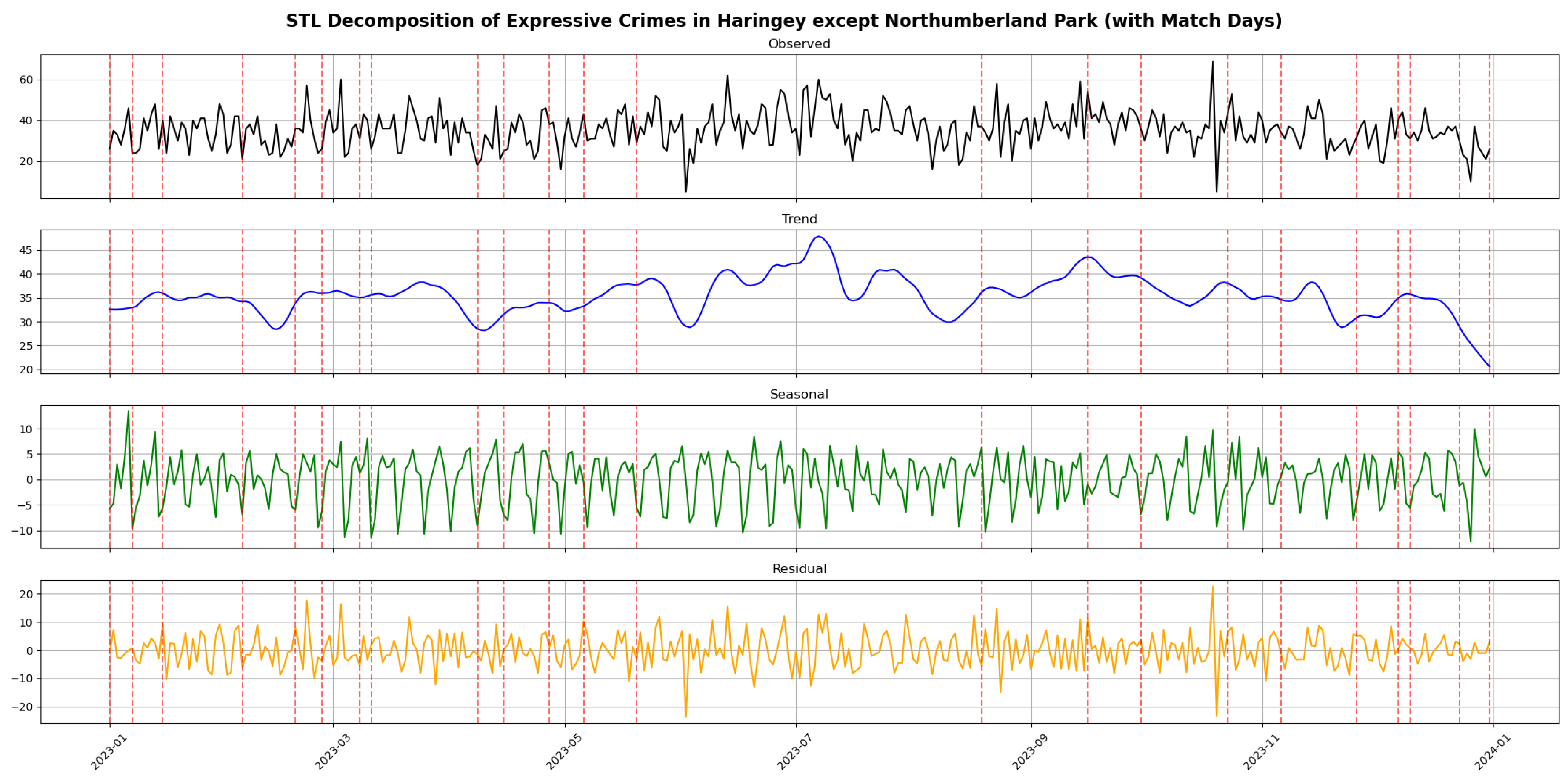
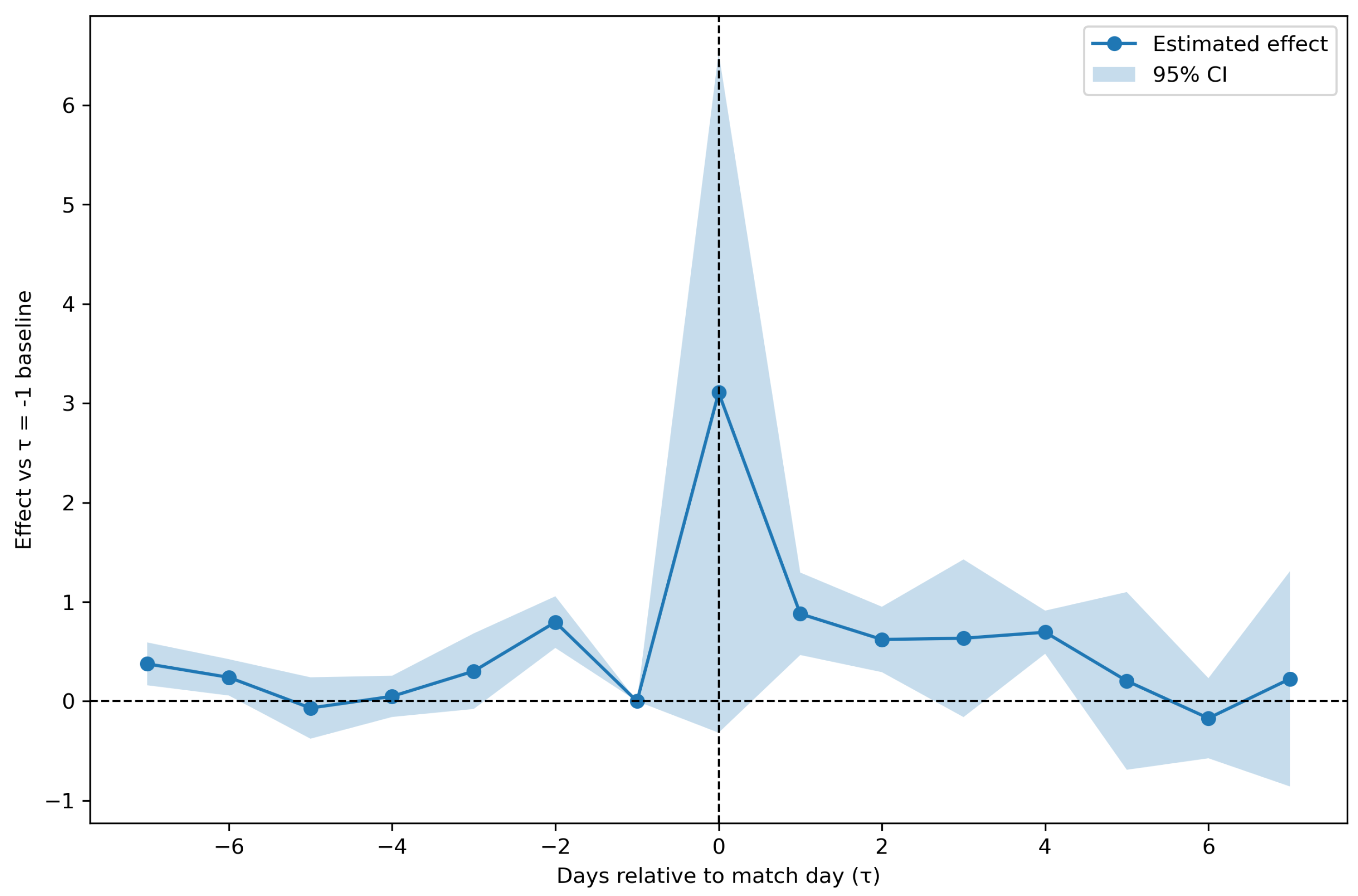
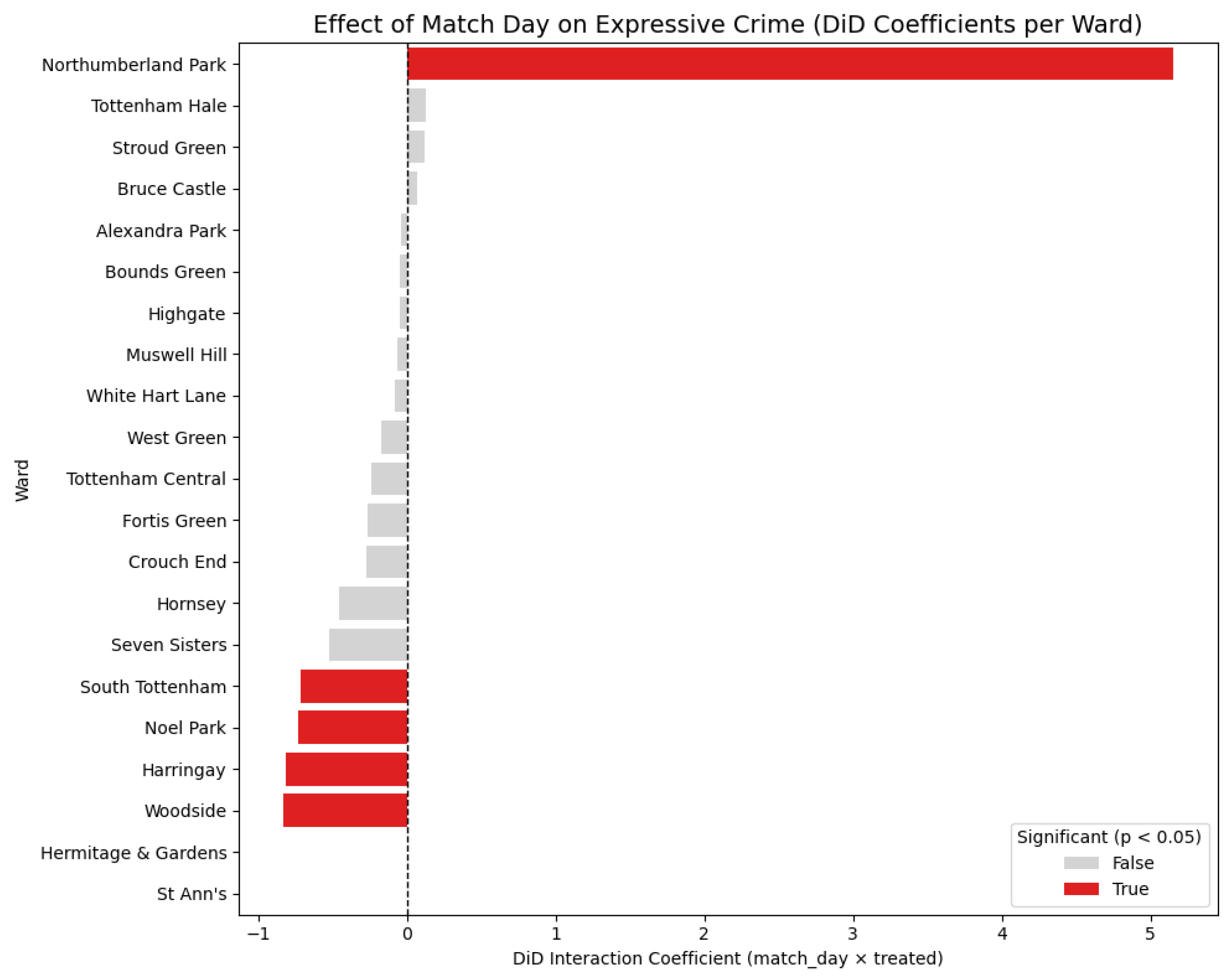

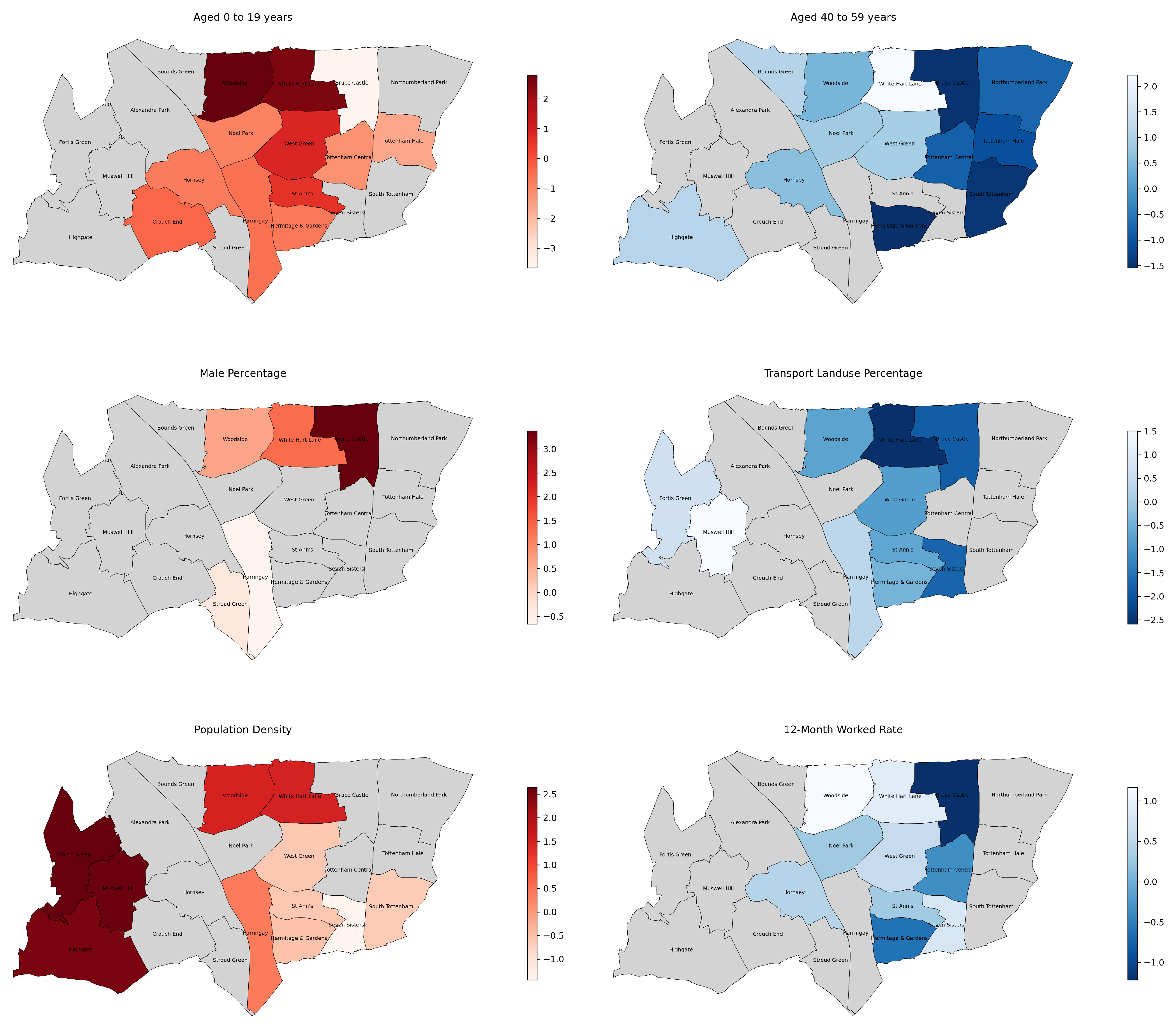

| Category | Data Type & Size | Source | Year | Description |
|---|---|---|---|---|
| Crime | Crime Records in London & 1,115,706 records | UK Police Open Data Portal (data.police.uk) | 2023 | Point-level crime records across London, including location, crime type, and month of occurrence. |
| Crime Counts in Haringey & 37,391 records | London Borough of Haringey Council | 2023 | Daily ward-level crime counts in Haringey. | |
| Sports | Sports Clubs & 7134 clubs | London Sport | 2023 | Number of sports clubs per ward in London. |
| Football Matches & 121 matches | Premier League (official website) | 2023 | Match schedule including date, teams, and results for Tottenham Hotspur Stadium. | |
| Socio- demographic Covariates | Census Data & 8 × 4994 entries | UK Census 2021 (ONS) | 2021 | Demographic and socioeconomic indicators: age structure, sex, economic activity, health, education, unemployment. |
| Index of Multiple Deprivation (IMD) & 7 × 4994 entries | UK Ministry of Housing, Communities & Local Government (MHCLG) | 2019 | Composite deprivation score at LSOA level, combining seven weighted domains (income, employment, education, health, crime, housing, environment); aggregated to the ward level in this study. | |
| Underground Passenger Flow & 312,191 entries and exits | Transport for London (TfL) | 2023 | Daily tap-in and tap-out counts at each Underground station. |
| Feature | VIF |
|---|---|
| TapIDW | 1.661 |
| Clubs | 1.983 |
| Income Deprivation | 8.491 |
| Health Deprivation | 8.719 |
| Living Environment Deprivation | 2.227 |
| Crime Deprivation | 7.060 |
| Aged 0 to 19 years | 1.594 |
| Aged 40 to 59 years | 3.976 |
| Male Percentage | 2.310 |
| Transport Landuse Percentage | 3.690 |
| Population Density | 5.462 |
| 12-Month Worked Rate | 2.116 |
Disclaimer/Publisher’s Note: The statements, opinions and data contained in all publications are solely those of the individual author(s) and contributor(s) and not of MDPI and/or the editor(s). MDPI and/or the editor(s) disclaim responsibility for any injury to people or property resulting from any ideas, methods, instructions or products referred to in the content. |
© 2025 by the authors. Published by MDPI on behalf of the International Society for Photogrammetry and Remote Sensing. Licensee MDPI, Basel, Switzerland. This article is an open access article distributed under the terms and conditions of the Creative Commons Attribution (CC BY) license (https://creativecommons.org/licenses/by/4.0/).
Share and Cite
Wang, R.; Li, Y.; Broca, S.; Patel, Z.; Sahota, I. Are Sport Clubs Mediating Urban Expressive Crimes?—London as the Case Study. ISPRS Int. J. Geo-Inf. 2025, 14, 409. https://doi.org/10.3390/ijgi14110409
Wang R, Li Y, Broca S, Patel Z, Sahota I. Are Sport Clubs Mediating Urban Expressive Crimes?—London as the Case Study. ISPRS International Journal of Geo-Information. 2025; 14(11):409. https://doi.org/10.3390/ijgi14110409
Chicago/Turabian StyleWang, Rui, Yijing Li, Sandeep Broca, Zakir Patel, and Inderpal Sahota. 2025. "Are Sport Clubs Mediating Urban Expressive Crimes?—London as the Case Study" ISPRS International Journal of Geo-Information 14, no. 11: 409. https://doi.org/10.3390/ijgi14110409
APA StyleWang, R., Li, Y., Broca, S., Patel, Z., & Sahota, I. (2025). Are Sport Clubs Mediating Urban Expressive Crimes?—London as the Case Study. ISPRS International Journal of Geo-Information, 14(11), 409. https://doi.org/10.3390/ijgi14110409






